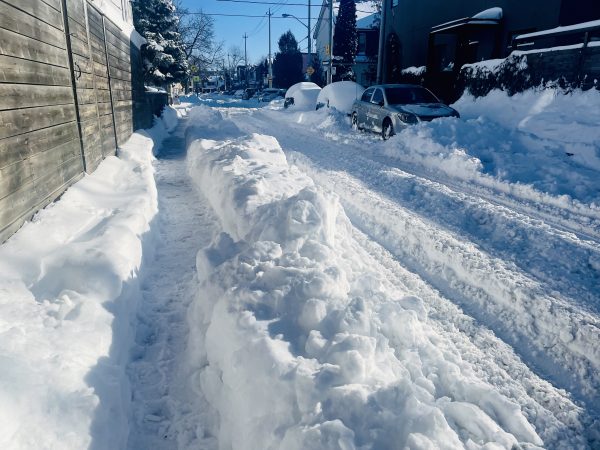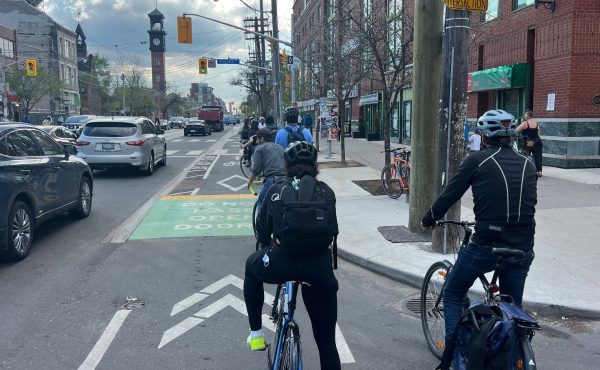A question for the immediate aftermath of the heaviest snowstorm in ten years: Following years of resident complaints and half-hearted lobbying from downtown councillors, the City of Toronto last year approved sidewalk snow shovelling for the older core neighbourhoods. Has it worked, or is this another example of the old adage, that one should beware of what one wishes for?
Anticipating one obvious response, it is not too soon to ask this question. The hours after a huge storm are precisely when the sidewalks need to be cleared, and the City’s standard (and understandable) pleas for patience are not consonant with the realities of moving around in a foot and a half of heavy-ish powder.
My entirely non-scientific observation is that about half the sidewalks on residential side streets were shovelled by late Monday afternoon, and that figure had risen to probably 90% by Tuesday morning.
How much due to the work of the guys driving those cute little snow plows? Who knows, but I have to say I’ve seen little evidence of this service in my part of the city.
This is not a knock on the municipal employees who have been tasked to clear the sidewalks in the old City of Toronto. There was a lot of snow. There are a lot of sidewalks. There are a lot of workers off sick or self-isolating. The ones on duty are doing their best.
So how come all the sidewalks are shovelled? The blindingly obvious answer, of course, is that most homeowners didn’t wait. They did what they’ve always done, which is to hold off until the storm ebbs, get their shovels out, and begin digging.
Before I continue, let me acknowledge the full range of human behaviour — from heroic public-mindedness to loathsome selfishness — when it comes to clearing sidewalks.
There are the people who will get going while it’s still blizzarding, and those hail-fellow characters with new Christmas snowblowers who take it upon themselves to clear out half a block on either side of their property, just to be neighbourly.
Then there are the minimalists — the one-shovel-wide-pathway folks — as well as the people who like it really tidy and the ones who leave ragged edges.
On the other side, the ones you curse at — the self-involved schmucks who dig out their front walk, the path to the driveway, and the entrance to said driveway, but leave the rest of the sidewalk covered. Or the snowbirds who’ve abandoned the city for points south and didn’t bother making arrangements.
Finally, there are all the city-dwellers for whom shovelling is genuinely too hard — older people without nearby family or considerate neighbours, people with disabilities, people with heart conditions, and so on.
But with the new plowing policy, we potentially have one more category of non-shovelers: those who decided to wait until the Bobcats and Kubotas come through, because, you know, that’s what the City has promised and that’s what I’m paying for.
It’s surely tempting, when picking through the streets after a blizzard like this one, to wonder how many of the uncleared walks belong to this new group. My guess: hardly any. After all, shovelling the sidewalk, for most people, isn’t an act of altruism; it’s a practical solution to getting around when there’s an abundance snow.
The new service, in other words, has create a weird, and perhaps unanticipated, civic riddle: do I wait for the plows, or simply do what I’ve always done and clear away the snow?
Most people, I’d predict, probably chose what’s behind door number two, and will then find themselves pondering the oddness of this new service when the plow does come through, a few days hence, clearing already cleared sidewalks.
The absence of downtown sidewalk plowing traces back to a Faustian bargain negotiated by the amalgamated council’s first budget chief Tom Jakobek, who was trading horses and favours with the suburban councillors.
But this story was never just about suburban-vs-downtown service levels. The variability of sidewalk widths, plus the proliferation of odd-ball obstacles in older neighbourhoods, made it genuinely more difficult to deliver the service. Then there’s the issue of street-parking, which means that plows have to thread the needle along narrow sidewalks without stripping the paint off now buried vehicles. The smaller vehicle the City has acquired can deal with most of these impediments, but I have definitely seen tire-track evidence of veering and dodging.
It may be the case that we’ve now entered a period of transition, when homeowners allow the old habits to die while waiting for the new service to deliver on its promise. But I doubt that the story will play out this way. Most people will continue to shovel their walks.
For the City, this problem raises an important question, which has to do with opportunity costs. If council has approved funds for sidewalk snow plowing downtown, and most people don’t bother waiting for the plow, it surely makes sense for the resources and the equipment to be used more effectively.
Lots of examples spring to mind: better clearing at corners, where the quasi-public realm of the sidewalk in front of a house bleeds into the fully public realm of the street. Prioritizing bike lane snow removal. Providing more timely service for seniors. Or targeting all those places which don’t seem to be anybody’s responsibility, of which there’s a long list.
The pandemic adds one more layer: since so many people have begun to walk more, and further, it seems to me that the City’s sidewalk plowing should be about ensuring connectivity and accessibility as opposed to relieving homeowners of a chore most will do one way or the other.
Again, none of these questions are coming up too soon. The City will never plow enough resources into plowing to ensure that the residential sidewalks are shovelled in a timely way, and the weather of the past two days is proof. There are better ways to clear the path.
photo by Matthew Blackett






11 comments
I got tired of waiting for the plow and cleared my sidewalk edge to edge (I’m one of those…) only to have the road plow dump all the snow off the road and onto my sidewalk 30 minutes later. My back can’t handle the much heavier road snow so now I wait for the sidewalk plow. Going by the TO plow website, there’s very little evidence that these plows exist in the numbers the city says they do, so it looks like it’s going to be a while.
It was so nice to be able to walk down Yonge St. on freshly plowed sidewalks Monday. It’s unbelievable how long it took to get this service in place. And is worth every penny I pay in taxes.
Remember the old days, where 2 out of 3 businesses (who would be closed) hadn’t shoveled.
I really feel it’s like a human right to have plowed sidewalks. The uncleared side streets were such a struggle to walk.
Just got back from a walk in the Annex Tuesday afternoon. No where near 90 % of the sidewalks are cleared. Most egregious was the sidewalk on the east side of Spadina just north of Bloor beside the Green P parking lot. The parking lot is well cleared, the sidewalk not at all. But there were many uncleared sidewalks where I was forced to detour into the street. So no, people don’t clear their sidewalks and yes, the city needs to do the job.
I certainly don’t expect my little dead-end street to be taken care of by the city – even when they send a road plow down it tends to make things worse. There’s just nowhere for the snow to go!
As someone who regularly walks to work and back I’d be more than happy with regularly cleared thoroughfare sidewalks because there isn’t much that’s more annoying than being forced to walk single-file through a narrow path in the snow.
This city sidewalk snow clearing service is a scam to inflate another city budget and higher more unionised workers.
Think about this carefully: according to city bylaws we are to remove the snow from our sidewalks within 12 hours of a snowfall or face a fine. So essentially we are forced to clear our snow within 12 hours and most probably follow this. Now, the city standards for their sidewalk snow removal service are between 12 and 72 hours. And judging by how much has been done now, 48 hours after the storm, and that according to Plow TO there are currently 0 plots on the sidewalks – it’s likely 72+ hours. The point, of course, is that the city does not even begin servicing sidewalks for hours to days after their own city bylaws force us to clear our own snow.
I live in Etobicoke central and I would say 65 to 70% of the residents where I live in suburbia shovel the sidewalk some even put salt and the other are like what for and just wait. I usually clear my sidewalk and neighbors sometimes when they cant
Those plows have engine and tire issues I know because I work in this department
Growing up in Montreal we enjoyed great sidewalk clearing. I have never understood why TO couldn’t manage to do the same.
This storm is a once in a generation event and to use it as a example of residential snow clearing is off target… when we have a regular snow fall that is when the plows are a blessing because most homeowners we’re not so diligent. Let us be thankful that the plows came and stop dumping on the city.
In Sweden ( https://usa.streetsblog.org/2018/01/24/why-sweden-clears-walkways-before-roads/ ) it’s walkways and bike paths first, especially those near transit stops and primary schools. Next, they clear local roads, and then, finally, highways.
Here in North America, it’s the first class motorist. Second and third class are the pedestrians and cyclists. Fourth class are the handicapped and incapacitated.
Toronto can’t hold a candle to Montreal on snow services. PR is in full swing now at city hall but can’t remove my feelings about this experience. In south Etobicoke, the plow left 1m+ high windrows that were about 1m+ deep. So after all our shovelling the day before, we found ourselves barricaded behind mountains of snow, gifted by the city. Emergency vehicles could have made it down the street but not into anyone’s home. Oh, and to add insult to injury, our street was immediately marked GREEN (completed) on that PlowTO map.